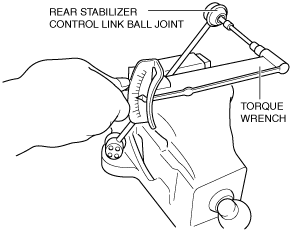 |
ac9wzw00003486
REAR STABILIZER CONTROL LINK INSPECTION
id021400800300
1. Remove the rear stabilizer control link. (See REAR STABILIZER REMOVAL [2WD].) (See REAR STABILIZER INSTALLATION [2WD].) (See REAR STABILIZER REMOVAL [4WD].) (See REAR STABILIZER INSTALLATION [4WD].)
2. Inspect the rear stabilizer control link for bends or damage.
3. Rotate the rear stabilizer control link ball joint stud 10 times and shake it side to side 10 times.
4. Install a hexagonal wrench to the rear stabilizer control link ball joint stud, and measure the starting torque of the rear stabilizer control link ball joint using a torque wrench.
ac9wzw00003486
|